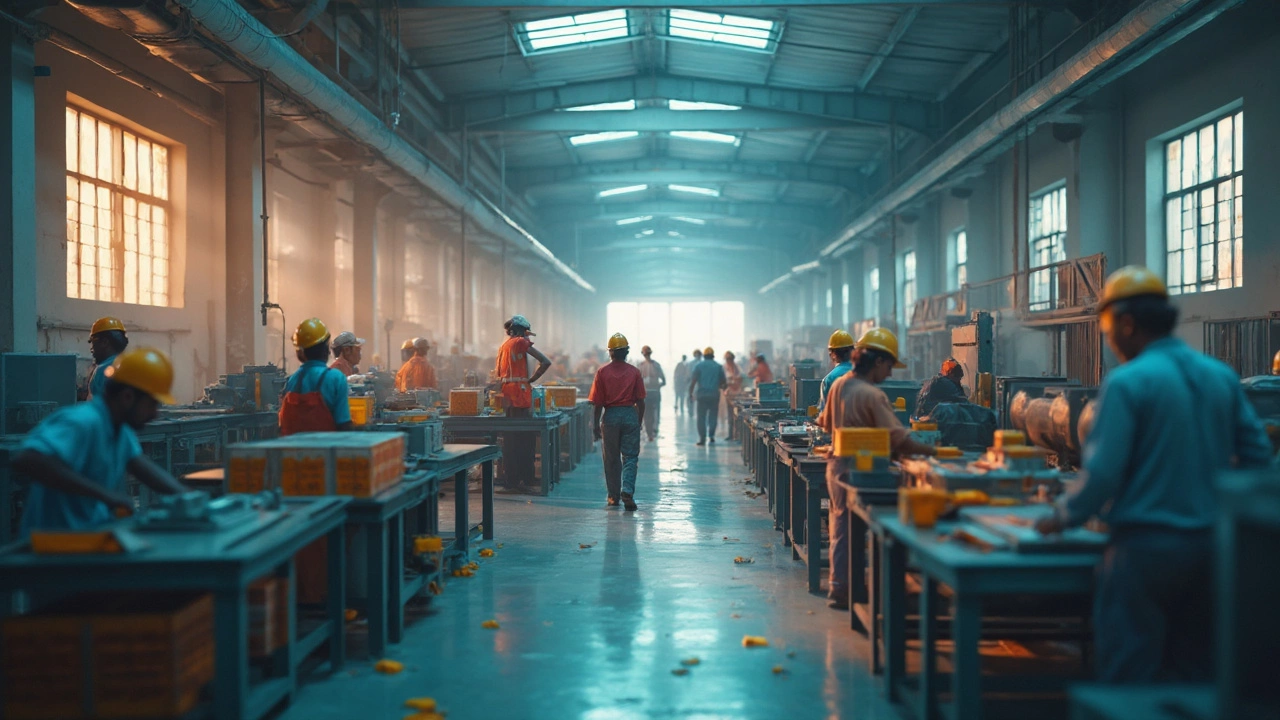
If you’re thinking about starting a factory, you already know it’s not just about machines and buildings—it’s about picking the right idea. The best factory to start in 2025 isn’t the one with the fanciest equipment, it’s the one that lines up with what customers actually want and what you can handle, cash and skills-wise.
Markets shift fast. Solar panels? They used to be “for the future”—now, local governments throw money at them, and customers can’t get enough. On the smaller end, simple stuff like disposable paper cups or eco-friendly packaging is exploding. Why? Because big brands need suppliers, and environmental rules keep getting stricter.
Don’t sleep on boring products, either. Factories making tiles, cleaning supplies, or basic hardware bring in reliable profits, especially when you focus on quality and quick delivery instead of racing to the bottom on price. Ever wonder why there are always new detergent brands at the store? High demand, low risk—hard to beat.
The smartest move isn’t chasing whatever’s trending on social media. Look at your local area, check import/export numbers, and talk to people in the business. That’s where the real gold is. So, if you’re itching to build something that lasts, focus less on “what’s hot everywhere” and more on “what sells here, now.”
- What Makes a Factory 'Best' Today?
- Hottest Factory Ideas (And Unexpected Winners)
- Crunching the Numbers: Startup Costs and Profits
- Tips for Getting Your Factory Off the Ground
What Makes a Factory 'Best' Today?
If you’re wondering what actually makes one factory stand out among all the options these days, you’re not alone. These days, it’s not just about pumping out the most units or having expensive machinery. The real winners are factories that blend a few key things: steady demand, easy sourcing, decent profit margins, and a solid place in the market.
- Steady demand: No matter how cool your product is, if people don’t buy it regularly, you’re risking downtime. Stuff like food packaging, cleaning products, and construction supplies stay in demand even when the economy takes a hit.
- Simple sourcing: You don’t want production held up waiting for special parts that only come from across the world. The best factories keep things simple – local materials where possible, reliable suppliers, and backups for everything.
- Profit margins: It’s all about what you keep, not just what you sell. Calculate the real cost for rent, labor, packaging, power, and shipping. A "best" factory idea usually has at least a 20% margin on average after all costs.
- Market fit: Factories that produce what the local market craves (or what nearby big manufacturers need) rarely sit idle. For example, making cardboard boxes might not sound exciting, but demand jumped over 10% worldwide since e-commerce blew up in 2020.
Check this out—here’s a quick look at some hot sectors and what’s driving the action:
| Sector | What Drives It | Notes |
|---|---|---|
| Eco-friendly Packaging | Ban on single-use plastics, e-commerce growth | High demand from local businesses, easy to scale up |
| Solar Panel Assembly | Government subsidies, green energy shift | Heavier regulations, but steady buyer interest |
| Detergent & Cleaning Supplies | Health concerns, regular usage | Great repeat business, but price competition |
| Tiles & Building Materials | Construction booms, urbanization | Logistics matter—local sells better than faraway |
The secret sauce behind the best factory to start is being realistic about your strengths. If you’re tight on startup funds, skip high-tech gadgets and go for proven, practical products. If you can spot new trends fast, take that risk where it counts—but always have your numbers straight. Chasing the unicorn idea rarely beats steady, boring profit. Factories that get this right don’t just survive—they grow, even when everyone else is scrambling.
Hottest Factory Ideas (And Unexpected Winners)
Picking what to make can feel overwhelming, but some factory ideas have taken off in 2024 and are still winning in 2025. Here’s what’s making real money and why they’re working—plus one or two that most people wouldn’t guess.
Factory ideas riding the “eco” trend keep growing. Fact: The global biodegradable packaging market topped $110 billion last year. Factories making compostable plates, paper straws, and molded pulp (think egg trays) are stacked with orders, especially near cities with single-use plastic bans. If your city or state is getting tougher on plastic, this is a safe bet.
Next up: solar panel assembly. In the U.S., companies that produce or assemble solar panels (especially smaller ones for homes and off-grid cabins) have doubled in number since 2022. Government tax credits and a sharp rise in home solar installations aren’t slowing down, so there’s room for new players here. You don’t need to build a full cell—the demand is huge just for assembling panels with imported parts.
Now, here’s where it gets weird. Factory owners making concrete blocks and tiles have no problem keeping busy. Housing and infrastructure projects haven’t stopped, even with interest rates high. Also, with the “build local” push, stores like Home Depot want more domestic suppliers. If you’ve got land and a reliable workforce, making building materials is a steady earner.
Want a surprise? Pet products, like natural dog treats or cat litter. In 2024, U.S. spending on pets hit $150 billion. Factories using upcycled food waste to make pet snacks or simple, dust-free litter are blowing up because people treat pets like family.
| Factory Type | Startup Cost (USD) | Annual Market Growth (2024) | Main Customers |
|---|---|---|---|
| Biodegradable Packaging | 100,000 - 300,000 | 5.8% | Retail, Fast Food, E-commerce |
| Solar Panel Assembly | 150,000 - 600,000 | 8.1% | Installers, Energy Companies, Homeowners |
| Building Materials (Blocks, Tiles) | 80,000 - 250,000 | 4.5% | Construction Firms, Wholesalers |
| Pet Products | 60,000 - 200,000 | 6.8% | Pet Stores, Supermarkets, Online |
The sweet spot? Find a product that’s boring but booming. Most people chase shiny gadgets—smart owners grab what everyone needs and repeat orders. If you want to play it safe, stick with stuff in the table above. If you spot a niche (like hypoallergenic cleaning supplies or solar-powered garden lights) with steady interest in your area, that could be your unexpected winner.

Crunching the Numbers: Startup Costs and Profits
Jumping into the factory game means watching your budget—hard. You don’t want to run out of cash halfway through, or worse, end up with a warehouse full of stuff nobody wants. Let’s break it down with real numbers.
Factory startup costs depend a lot on what you’re making. For small items like paper cups or packing materials, you could start with as little as $30,000 to $50,000, covering basic equipment, rent, and raw materials for the first round. Bump that up to $150,000 and you’re looking at small furniture or solar panel assembly. Heavy stuff like ceramics or metal parts? Factory setup can cross $250,000 fast.
Most owners ignore the hidden costs—things like business permits, insurance, labor, and waste disposal. Labor alone eats 25-40% of your budget if you’re hiring full time. Plus, utility bills. The bigger the machines, the higher the power bill. Seriously, don’t undershoot these line items.
| Factory Type | Average Startup Cost (USD) | Gross Margin (%) | Payback Period |
|---|---|---|---|
| Disposable Paper Products | $40,000 - $65,000 | 18-25 | 10-14 months |
| Solar Panel Assembly | $120,000 - $180,000 | 22-30 | 14-22 months |
| Eco Packaging | $50,000 - $110,000 | 21-28 | 12-16 months |
| Ceramic Tiles | $200,000 - $300,000 | 15-20 | 20-36 months |
Profit margins look best on lower-tech items, mainly because you’re not fighting with multinational giants. But don’t just chase high margins without checking demand and competition. Smart owners run a break-even analysis before signing anything—how many units do you have to sell every month to cover costs? Don’t guess; use real supplier quotes and local rates.
One extra tip: look out for local grants or tax perks for new factories, especially those promising clean energy, recycling, or job creation. Chasing these can slash your payback time by months, sometimes more. And when banks see you’ve got a plan, they say yes to loans way quicker.
Tips for Getting Your Factory Off the Ground
Starting a factory sounds massive, but most successful ones start small and scale up. Before spending a dime, get real about what your market needs and how much you can actually handle. Here’s what really matters:
- Plan Like Your Wallet Depends On It: Write down every expense—even duct tape and light bulbs count. Most folks forget power costs, insurance, or how often machines break. The Small Business Administration says start-up costs for small factories in the U.S. average between $250,000 and $1 million, depending on what you make.
- Pick a Location That Works for You (and Your Deliveries): Look for places near highways, cheap power, and a good labor pool. If shipping eats your profits, you’re toast. Fun fact: More than 70% of U.S. manufacturers pick sites less than an hour from major interstates.
- Get the Right Licenses Early: Don’t wait until the paint dries. Each product has its own rules. For example, making food or anything medical means surprise inspections—skip a step, and you could get shut down fast.
- Find Reliable Suppliers: One hiccup in supplies can stop your production line. A single missed part can halt an entire factory for days. Ask other factory owners who they use; word-of-mouth beats Google here.
- Quality Beats Quantity, Especially at the Start: Don’t chase huge orders before you can handle them. Bad reviews will haunt you, especially if you’re local. Most new factories win repeat business because their stuff actually works.
Here’s a snapshot of common startup costs for a small factory making simple consumer goods:
| Cost Type | Typical Range (USD) |
|---|---|
| Factory Space Lease | $2,000 - $8,000/mo |
| Raw Materials (First 3 Months) | $20,000 - $60,000 |
| Basic Machinery | $80,000 - $300,000 |
| Permits & Licenses | $2,000 - $10,000 |
| Labor (First Month) | $10,000 - $25,000 |
| Utilities & Insurance | $3,000 - $8,000 |
The best factory start-ups keep things easy and lean at first. Automate only what you need, hire slow, and remember: it’s easier to add new machines later than to pay off debt from buying everything at once. If you’re tight on cash, look at government grants for manufacturing—these pop up regularly and can help cover equipment or training costs.
Finally, don’t skip networking. Local business meetups or your regional manufacturing chamber are goldmines for deals, advice, and sometimes even clients. The people you know can make or break your launch, sometimes more than your business plan.